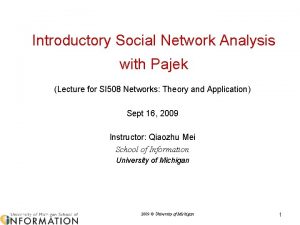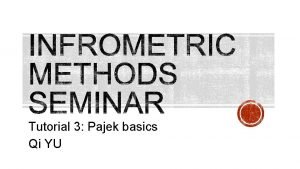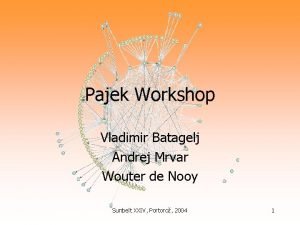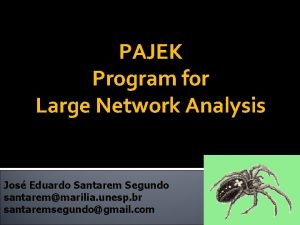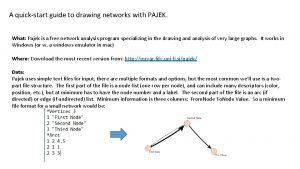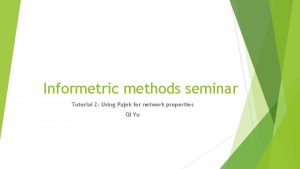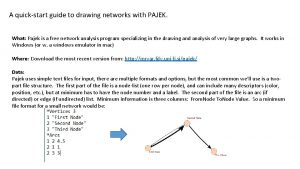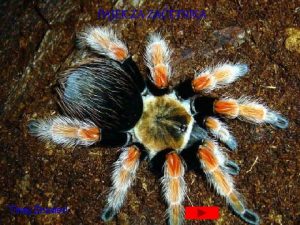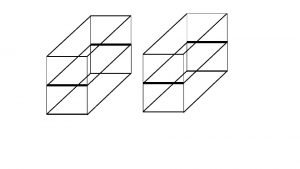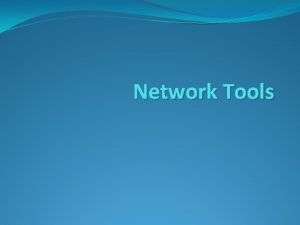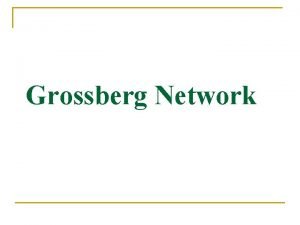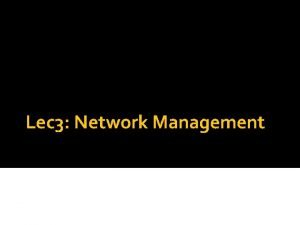Network Pajek Introduction Pajek is a program for








































![Strong component of cite network ¥ ¥ Network/Create Partition/Components/Strong [2] Operations/Network+Partition/Extract Sub. Network [1 Strong component of cite network ¥ ¥ Network/Create Partition/Components/Strong [2] Operations/Network+Partition/Extract Sub. Network [1](https://slidetodoc.com/presentation_image/2e7c077e9ed9bb4015177ae3203a6b6f/image-41.jpg)

![Bibliographic coupling network ¥ ¥ ¥ [Read Cite. net] Network/Create New Network/Transform/1 -mode to Bibliographic coupling network ¥ ¥ ¥ [Read Cite. net] Network/Create New Network/Transform/1 -mode to](https://slidetodoc.com/presentation_image/2e7c077e9ed9bb4015177ae3203a6b6f/image-43.jpg)
![Co-citation network ¥ ¥ ¥ ¥ [Read Cite. net] Network/Create Partitions/Degree/Output Operations/Network+Partition/Extract sub. Network Co-citation network ¥ ¥ ¥ ¥ [Read Cite. net] Network/Create Partitions/Degree/Output Operations/Network+Partition/Extract sub. Network](https://slidetodoc.com/presentation_image/2e7c077e9ed9bb4015177ae3203a6b6f/image-44.jpg)

































- Slides: 77

Network Pajek

Introduction ¥ Pajek is a program, for Windows, for analysis and visualization of large networks having some thousands or even millions of vertices. In Slovenian language the word pajek means spider.

Application ¥ Pajek should provide tools for analysis and visualization of such networks: ¥ ¥ ¥ ¥ ¥ collaboration networks, organic molecule in chemistry, protein-receptor interaction networks, genealogies, Internet networks, citation networks, diffusion (AIDS, news, innovations) networks, data-mining (2 -mode networks), etc. See also collection of large networks at: ¥ http: //vlado. fmf. uni-lj. si/pub/networks/data/

Main goals ¥ to support abstraction by (recursive) decomposition of a large network into several smaller networks that can be treated further using more sophisticated methods; ¥ to provide the user with some powerful visualization tools; ¥ to implement a selection of efficient (subquadratic) algorithms for analysis of large networks.

six data structures in pajek ¥ network – main object (vertices and lines - arcs, edges): ¥ ¥ partition ¥ ¥ reordering of vertices. Default extension: . per cluster ¥ ¥ Values of vertices numerical property of vertices. Default extension: . vec permutation ¥ ¥ To which cluster a vertex belongs, Nominal property of vertices. Default extension: . clu vector ¥ ¥ graph, valued network, 2 -mode or temporal network subset of vertices (e. g. a class from partition). Default extension: . cls. hierarchy ¥ hierarchically ordered clusters and vertices. Default extension: . hie

Network –. net ¥ ¥ Network can be defined in different ways on input file. Look at three of them: 1. List of neighbours (Arcslist / Edgeslist)(see test 1. net) *Vertices 5 1 ”a” 2 ”b” 3 ”c” 4 ”d” 5 ”e” *Arcslist 1 2 4 2 3 3 1 4 4 5 *Edgeslist 1 5


Explanation ¥ ¥ ¥ ¥ Data must be prepared in an input (ASCII) file. Program Note. Pad can be used for editing. Much better is a shareware editor, Text. Pad. Words, starting with *, must always be written in first column of the line. They indicate the start of a definition of vertices or lines. Using *Vertices 5 we define a network with 5 vertices. This must always be the first statement in definition of a network. Definition of vertices follows after that – to each vertex we give a label, which is displayed between “ and ”. Using *Arcslist, a list of directed lines from selected vertices are declared (1 2 4 means, that there exist two lines from vertex 1, one to vertex 2 and another to vertex 4). Similarly *Edgeslist, declares list of undirected lines from selected vertex. In the file no empty lines are allowed – empty line means end of network.

Network –. net ¥ 2. Pairs of lines (Arcs / Edges) (see test 2. net) *Vertices 5 1 ”a” 2 ”b” 3 ”c” 4 ”d” 5 ”e” *Arcs 1 2 1 1 4 1 2 3 1 1 3 4 2 4 5 1 *Edges 1 5 1

Explanation Directed lines are defined using *Arcs, undirected lines are defined using *Edges. The third number in rows defining arcs/edges gives the value/weight of the arc/edge. ¥ In the previous format (Arcslist / Edgeslist) values of lines are not defined ¥ ¥ the format is suitable only if all values of lines are 1. If values of lines are not important the third number can be omitted (all lines get value 1). ¥ In the file no empty lines are allowed – empty line means end of network. ¥

Network –. net ¥ 3. Matrix (see test 3. net) *Vertices 5 1 ”a” 2 ”b” 3 ”c” 4 ”d” 5 ”e” *Matrix 0 1 1 0 0 2 0 0 0 0 0 1 1 0 0

Explanation ¥ In this format directed lines (arcs) are given in the matrix form (*Matrix). If we want to transform bidirected arcs to edges we can use “Network>create new network>Transform>Arcs to Edges>Bidirected only”

Additional definition of network ¥ ¥ Additionally, Pajek enables precise definition of elements used for drawing networks (coordinates of vertices, shapes and colors of vertices and lines, . . . ). Example: (see test 4. net) *Vertices 5 1 “a” box 2 “b” ellipse 3 “c” diamond 4 “d” triangle 5 “e” empty. . .

Draw ¥ Layout of networks ¥ Energy: The network is presented like a physical system, and we are searching for the state with minimal energy Kamada-Kawai: using separate components, you can tile connected components in a plane ¥ Fruchterman-Reingold: draw in a plane or space and selecting the repulsion factor ¥ ¥ Eigen Values: Selecting 2 or 3 eigenvectors to become the coordinates of vertices. Can obtain nice pictures

Partition –. clu ¥ Partitions are used to describe nominal properties of vertices. ¥ e. g. , 1 -men, 2 -women ¥ Definition in input file (see test. clu) *Vertices 5 1 2 2 2 1

Vector – . vec ¥ Vectors are used to describe numerical properties of vertices (e. g. , centralities). ¥ Definition in input file (see test. vec) *Vertices 5 0. 58 0. 25 0. 08 0. 25

Pajek project files ¥ It is time consuming to load objects one by one. Therefore it is convenient to store all data in one file, called Pajek project file (. paj). (see test. paj) ¥ Project files can be produced manually by using “File>Pajek Project File>Save” ¥ To load objects stored in Pajek project file select “File>Pajek Project File>Read”

Menu structure ¥ ¥ ¥ Commands are put to menu according to the following criterion: commands that need only a network as input are available in menu Net, commands that need as input two networks are available in menu Networks, commands that need as input two objects (e. g. , network and partition) are available in menu Operations, commands that need only a partition as input are available in menu Partition. . .

Global and local views on network

Global and local views on network Local view is obtained by extracting subnetwork induced by selected cluster of vertices. ¥ Global view is obtained by shrinking vertices in the same cluster to new (compound) vertex. In this way relations among clusters of vertices are shown. ¥ Combination of local and global view is contextual view: Relations among clusters of vertices and selected vertices are shown. ¥

Example ¥ Import and export in 1994 among 80 countries are given. They is given in 1000$. (See Country_Imports. net) ¥ Partition according to continents (see Country_Continent. clu) ¥ 1 – Africa, 2 – Asia, 3 – Europe, 4 – N. America, 5 – Oceania, 6 – S. America.

Extracting Subnetwork ¥ Operations>Network+Partition>Extract Subnetwork

Removing lines with low values ¥ Network>Info>Line Values

Removing lines with low values ¥ Network>Create New Network>Transform>Remove>Lines with value>lower than (340000)

Resources ¥ Download ¥ ¥ Text file into Pajek ¥ ¥ http: //vlado. fmf. unilj. si/pub/networks/pajek/Wo. S 2 Pajek/default. htm Tutorial ¥ ¥ http: //vlado. fmf. uni-lj. si/pub/networks/pajek/howto/text 2 pajek. htm Wo. S to Pajek ¥ ¥ The latest version of Pajek is freely available, for non-commercial use, at its home page: http: //vlado. fmf. unilj. si/pub/networks/pajek/ Exploratory Social Network Analysis with Pajek visit Pajek wiki for more information ¥ http: //pajek. imfm. si/doku. php

http: //pajek. imfm. si/doku. php? id=wos 2 pajek/ WOS TO PAJEK

Web of Science S 519

Output S 519

Output S 519

wos 2 pajek ¥ The download link: ¥ http: //pajek. imfm. si/doku. php? id=wos 2 pajek ¥ The new tutorial slides: ¥ http: //pajek. imfm. si/lib/exe/fetch. php? media=f aq: wos 2 pajek 07. pdf

Monty. Lingua ¥ Download from: http: //web. media. mit. edu/~hugo/montyling ua/ ¥ Unpack it and copy ‘montylingua-2. 1’ to C: Program Files (x 86)Python 27Libsitepackages ¥ Set up a new environment variable named ‘MONTYLINGUA’ and set the variable value as C: Program Files (x 86)Python 27Libsite-

wos 2 pajek ¥ Download the latest version of Wo. S 2 Pajek. ¥ http: //pajek. imfm. si/doku. php? id=wos 2 pajek ¥ Unpack it, and double click on Wo. S 2 Pajek. py to show the main interface of program:


You can also put all wos files in a folder

Wo. S 2 Pajek Program ¥ The current version of Wo. S 2 Pajek requires 7 parameters to be given by the user: ¥ ¥ ¥ ¥ Monty. Lingua directory: path to the directory in which the Monty. Lingua package is installed; project directory: where the output files are saved; Wo. S file; maxnum – estimate of the number of all vertices (number of records+number of cited Works) – 30*number of records; step – prints info about each k*step record as a trace; step= 0– no trace. use ISI name / short name; make a clean Wo. S file without duplicates; boolean list[DE, ID, TI, AB] specifying which fields are sources of keywords.

Wos-pajek. txt



Cite. net ¥ ¥ ¥ Network/Info/General Network/Create New Network/Transform/Remove/Loops Network/Create New Network/Transform/Remove/Multiple lines/Single line

Cite. New. net ¥ Paper citation network ¥ Questions What are highly cited articles? ¥ The diameter of the network? ¥ What are the major clusters? ¥ More questions? ¥
![Strong component of cite network NetworkCreate PartitionComponentsStrong 2 OperationsNetworkPartitionExtract Sub Network 1 Strong component of cite network ¥ ¥ Network/Create Partition/Components/Strong [2] Operations/Network+Partition/Extract Sub. Network [1](https://slidetodoc.com/presentation_image/2e7c077e9ed9bb4015177ae3203a6b6f/image-41.jpg)
Strong component of cite network ¥ ¥ Network/Create Partition/Components/Strong [2] Operations/Network+Partition/Extract Sub. Network [1 -*] Operations/Network+Partition/Transform/Remove Lines/Between Cluster Save citestrong. clu

Co-author network ¥ Read WA. net Network/2 -mode network/2 -mode to 1 -mode/Columns Network/Create Partition/Components/Weak [2] Operations/Network+Partition/Extract Sub. Network[1 -*] Network/Create New Network/Transform/Remove/Loops ¥ WANew. net (which is a co-author network) ¥ Questions: ¥ ¥ ¥ The author with highest co-authors?
![Bibliographic coupling network Read Cite net NetworkCreate New NetworkTransform1 mode to Bibliographic coupling network ¥ ¥ ¥ [Read Cite. net] Network/Create New Network/Transform/1 -mode to](https://slidetodoc.com/presentation_image/2e7c077e9ed9bb4015177ae3203a6b6f/image-43.jpg)
Bibliographic coupling network ¥ ¥ ¥ [Read Cite. net] Network/Create New Network/Transform/1 -mode to 2 mode Network/2 -mode to 1 -mode/Rows Network/Create Partition/Components/Weak [2] Operations/Network + Partition/Extract Sub. Network [1 -*]
![Cocitation network Read Cite net NetworkCreate PartitionsDegreeOutput OperationsNetworkPartitionExtract sub Network Co-citation network ¥ ¥ ¥ ¥ [Read Cite. net] Network/Create Partitions/Degree/Output Operations/Network+Partition/Extract sub. Network](https://slidetodoc.com/presentation_image/2e7c077e9ed9bb4015177ae3203a6b6f/image-44.jpg)
Co-citation network ¥ ¥ ¥ ¥ [Read Cite. net] Network/Create Partitions/Degree/Output Operations/Network+Partition/Extract sub. Network [1 -*] Network/Create New Network/Transform/1 -mode to 2 mode Network/2 -mode network/2 -mode to 1 -mode/Columns Network/Create Partition/Components/Weak [2] Operations/Network+Partition/Extract Sub. Network [1 -*]

NETWORK ANALYSIS

Two-mode network ¥ One-mode network ¥ each vertex can be related to each other vertex. ¥ Two-mode network ¥ vertices are divided into two sets and vertices can only be related to vertices in the other set.

Example ¥ Suppose we have data as below: ¥ ¥ ¥ ¥ ¥ P 1: Au 1, Au 2, Au 5 P 2: Au 2, Au 4, Au 5 P 3: Au 4 See two_mode. net P 4: Au 1, Au 5 P 5: Au 2, Au 3 P 6: Au 3 P 7: Au 1, Au 5 P 8: Au 1, Au 2, Au 4 P 9: Au 1, Au 2, Au 3, Au 4, Au 5 P 10: Au 1, Au 2, Au 5 *vertices 15 10 1 "P 1" 2 "P 2" 3 "P 3" 4 "P 4" 5 "P 5" 6 "P 6" 7 "P 7" 8 "P 8" 9 "P 9" 10 "P 10" 11 "Au 1" 12 "Au 2" 13 "Au 3" 14 "Au 5" 15 "Au 5" *edgeslist 1 11 12 15 2 12 14 15 3 14 4 11 15 5 12 13 6 13 7 11 15 8 11 12 14 9 11 12 13 14 15 10 11 12 15

Transforming to valued networks ¥ The network is transformed into an ordinary network, where the vertices are elements from the first subset, using ¥ “Network>2 mode network>2 -Mode to 1 -Mode>Rows”.

Transforming to valued networks ¥ If we want to get a network with elements from the second subset we use ¥ “Network>2 mode network>2 -Mode to 1 Mode>Columns”.

Basic information about a network ¥ Basic information can be obtained by “Network>Info>General” which is available in the main window of the program. We get ¥ ¥ ¥ number of vertices number of arcs, number of directed loops number of edges, number of undirected loops density of lines Additionally we must answer the question: ¥ ¥ Input 1 or 2 numbers: +/highest, -/lowest where we enter the number of lines with the highest/lowest value or interval of values that we want to output. If we enter 10 , 10 lines with the highest value will be displayed. If we enter -10, 10 lines with the lowest value will be displayed. If we enter 3 10 , lines with the highest values from rank 3 to 10 will be displayed.

Metformin Network ¥ Load metformin network to Pajek

Entity. Metrics Entitymetrics is defined as using entities (i. e. , evaluative entities or knowledge entities) in the measurement of impact, knowledge usage, and knowledge transfer, to facilitate knowledge discovery. Ding, Y. , Song, M. , Han, J. , Yu, Q. , Yan, E. , Lin, L. , & Chambers, T. (2013). Entitymetrics: Measuring the impact of entities. PLo. S One, 8(8): 1 -14.

Entity. Metrics

Diameter of the network ¥ Network/Create New Network/Sub. Network with Paths/Info on Diameter ¥ Pajek returns only the two vertices that are the furthest away.

Component ¥ Strongly connected components ¥ ¥ ¥ Weakly connected components ¥ ¥ ¥ A weakly connected component is a maximal group of nodes that are mutually reachable by violating the edge directions. Network>Create Partition>Components>Weak Result is represented by a partition ¥ ¥ Every vertex is reachable from every other vertex Network>Create Partition>Components>Strong vertices that belong to the same component have the same number in the partition. Example ¥ component. net

Component. net

Weak Component ¥ Go to partition weak component, ¥ Partition>make network>random network>Input ¥ Visualize the new random network

Weak Component

Strong Component

Strong Component

Bicomponent ¥ A cut-vertex is a vertex whose deletion increases the number of components in the network. ¥ A bi-component is a component of minimum size 3 that does not contain a cut -vertex.

Bicomponent example

Bicomponent ¥ ¥ Network/Create New Network/. . . with Bi-Connected Components stored as Relation Numbers Bicommponents are stored in hierarchy Load USAir 97. net Get bicomponents with (14 of them) with component size >3

Bicomponent ¥ The largest component is 244 airports

Bicomponents ¥ ¥ Hierarchy>Extract Cluster (13), then result is stored in cluster Draw the cluster

Bicomponents ¥ Operations>Network+Cluster>Extract Sub. Network

Bicomponents ¥ ¥ Operations>Network+Cluster>Extract Sub. Network The info about the largest cluster (244)

Bicomponents ¥ Network>Create Partition>Degree>Input ¥ Busy airports

K-Cores ¥ ¥ ¥ A subset of vertices is called a k-core if every vertex from the subset is connected to at least k vertices from the same subset. K-Cores can be computed using “Network>Create Partitions>K-Core” and selecting Input, Output or All core. Result is a partition: for every vertex its core number is given. In most cases we are interested in the highest core(s) only. The corresponding subnetwork can be extracted using “Operations>Extract from Network>Partition” and typing the lower and upper limit for the core number. Example ¥ See k_core. net

K_core. net

Clustering Coefficients ¥ How three nodes are connected ¥ Calculation of local Clustering Coefficients: Network>Create Vector>Clustering Coefficients>CC 1 ¥ K_core. net ¥

Degree Centrality ¥ Degree centrality ¥ Network>Create Partition>Degree, or ¥ Network/Create Vector/Centrality/Degree; Example: Metformin network ¥

Betweenness Centrality ¥ ¥ How nodes are connecting different clusters Betweenness centrality ¥ Network>Create vector>Centrality>Betweenness

Betweenness Centrality ¥ The betweenness centrality value for each node

Closeness Centrality ¥ Closeness centrality ¥ ¥ Network>Create Vector>Centrality>Closeness Showing how one node is close to all other nodes in the network

Shortest Path ¥ ¥ Network/Create New Network/Sub. Network with Paths/. . . One Shortest Path between Two Vertices Enter two vertices ¥ Forget values on lines ¥ ¥ ¥ Identify vertices in source network ¥ ¥ ¥ Yes, if searching for the shortest path is based on lengths No, if searching for the shortest path is based on value of lines No Result will be a new subnetwork containing the two selected vertices Layout>Energy>Kamada Kawai>Fix first and last

Shortest Path ¥ ¥ Network/Create New Network/Sub. Network with Paths/. . . One Shortest Path between Two Vertices (17 -7045) Network/Create New Network/Sub. Network with Paths/. . . All Shortest Paths between Two Vertices (17 -7045) 17: GENE_otc 7045: GENE_ube 2 v 1
 Pajek
Pajek Pajek tutorial
Pajek tutorial Morski pajek rak
Morski pajek rak Pajek
Pajek Fspos vägledning för kontinuitetshantering
Fspos vägledning för kontinuitetshantering Typiska novell drag
Typiska novell drag Tack för att ni lyssnade bild
Tack för att ni lyssnade bild Vad står k.r.å.k.a.n för
Vad står k.r.å.k.a.n för Shingelfrisyren
Shingelfrisyren En lathund för arbete med kontinuitetshantering
En lathund för arbete med kontinuitetshantering Särskild löneskatt för pensionskostnader
Särskild löneskatt för pensionskostnader Personlig tidbok fylla i
Personlig tidbok fylla i Sura för anatom
Sura för anatom Vad är densitet
Vad är densitet Datorkunskap för nybörjare
Datorkunskap för nybörjare Stig kerman
Stig kerman Debatt mall
Debatt mall Magnetsjukhus
Magnetsjukhus Nyckelkompetenser för livslångt lärande
Nyckelkompetenser för livslångt lärande Påbyggnader för flakfordon
Påbyggnader för flakfordon Lufttryck formel
Lufttryck formel Offentlig förvaltning
Offentlig förvaltning Kyssande vind analys
Kyssande vind analys Presentera för publik crossboss
Presentera för publik crossboss Teckenspråk minoritetsspråk argument
Teckenspråk minoritetsspråk argument Bat mitza
Bat mitza Treserva lathund
Treserva lathund Fimbrietratt
Fimbrietratt Bästa kameran för astrofoto
Bästa kameran för astrofoto Centrum för kunskap och säkerhet
Centrum för kunskap och säkerhet Byggprocessen steg för steg
Byggprocessen steg för steg Mat för idrottare
Mat för idrottare Verktyg för automatisering av utbetalningar
Verktyg för automatisering av utbetalningar Rutin för avvikelsehantering
Rutin för avvikelsehantering Smärtskolan kunskap för livet
Smärtskolan kunskap för livet Ministerstyre för och nackdelar
Ministerstyre för och nackdelar Tack för att ni har lyssnat
Tack för att ni har lyssnat Referatmarkering
Referatmarkering Redogör för vad psykologi är
Redogör för vad psykologi är Borstål, egenskaper
Borstål, egenskaper Atmosfr
Atmosfr Borra hål för knoppar
Borra hål för knoppar Orubbliga rättigheter
Orubbliga rättigheter Relativ standardavvikelse formel
Relativ standardavvikelse formel Tack för att ni har lyssnat
Tack för att ni har lyssnat Steg för steg rita
Steg för steg rita Informationskartläggning
Informationskartläggning Tobinskatten för och nackdelar
Tobinskatten för och nackdelar Blomman för dagen drog
Blomman för dagen drog Mästar lärling modellen
Mästar lärling modellen Egg för emanuel
Egg för emanuel Elektronik för barn
Elektronik för barn Antikt plagg
Antikt plagg Strategi för svensk viltförvaltning
Strategi för svensk viltförvaltning Kung dog 1611
Kung dog 1611 Ellika andolf
Ellika andolf Sju för caesar
Sju för caesar Tack för att ni lyssnade
Tack för att ni lyssnade Samlade siffror för tryck
Samlade siffror för tryck Rim dikter
Rim dikter Inköpsprocessen steg för steg
Inköpsprocessen steg för steg Fuktmätningar i betong enlig rbk
Fuktmätningar i betong enlig rbk Ledarskapsteorier
Ledarskapsteorier Exspektans eller expektans
Exspektans eller expektans Myndigheten för delaktighet
Myndigheten för delaktighet Trög för kemist
Trög för kemist Sju principer för tillitsbaserad styrning
Sju principer för tillitsbaserad styrning Läkarutlåtande för livränta
Läkarutlåtande för livränta Tät skog karttecken
Tät skog karttecken Gumman cirkel
Gumman cirkel Shivaismen
Shivaismen Mitos steg
Mitos steg Bris för vuxna
Bris för vuxna Jätte råtta
Jätte råtta Difference between datagram and virtual circuit
Difference between datagram and virtual circuit Types of network topology
Types of network topology Features of peer to peer network and client server network
Features of peer to peer network and client server network Ece 526
Ece 526
